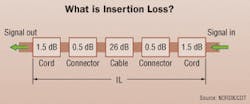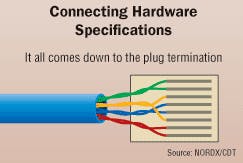How cabling parameters affect your network's performance
Characteristics like ILD and return loss are closely related to a system's connecting hardware.
Your cabling system is like a bridge or a roadway that moves information between different parts of your network, from a source to a receiver. It is vitally important that your roadway is constructed on a solid foundation, using high-performance matched components with enough capacity to support today's and tomorrow's high-speed data applications, and without loss of information.
This article will focus on the performance of next-generation Category 6 cabling, and what makes it different from the performance of existing Category 5 and Category 5e systems. Key to unraveling the mystery of cabling and its affect on performance is understanding the following parameters: insertion loss (IL), insertion loss deviation (ILD), return loss, and noise from various sources.
Connecting hardware is a critical piece of the Category 6 system. Most of the Category 6 standards-development work carried out so far has focused on connecting and associated modular-cord requirements to achieve the specified performance level, backward compatibility with Category 5 and 5e systems, and interoperability among different vendors' Category 6 systems. The best way to describe connecting-hardware performance is to say it is a delicate balancing act. To understand how these parameters really affect your network performance, it is important to relate them to signal-to-noise ratio (SNR).
IL (frequently called "attenuation") measures the loss of signal power between the input and output of a channel. A low insertion loss, measured in decibels, means a stronger signal. A stronger signal is less susceptible to environmental noise, and has higher information-carrying capacity than a weaker signal. IL is measured, using field test equipment, as a function of frequency. For Category 5 and 5e cabling systems, the frequency range is 1 to 100 MHz. For Category 6, it is 1 to 250 MHz.
Return loss is a measure of the mismatch between components in a channel. Ideally, all components have a nominal 100-W impedance. In practice, components are different because of design, manufacturing, and installation variances. A high return loss, also measured in dB, means fewer reflections and well-matched components. Signal reflections are a source of noise, which contributes to errors. High return loss is important for gigabit-speed operation because 1000Base-T, Gigabit Ethernet, is a bi-directional system-meaning a signal transmits in both directions on each pair.
All other cabling parameters can be related to internal noise-such as near-end and far-end crosstalk-or external noise, such as alien crosstalk. A high crosstalk loss, measured in dB, means less noise and a clearer signal, which in turn means fewer errors. Internal noise is generated when a signal that is sent on one pair couples onto an adjacent pair within the same cable. Noise can also be introduced from external sources, such as other cables, induced power-line transients, or in the case of shielded cables, noise conducted along the cable shield caused by ground return currents.
Additional loss sources
Determining insertion loss is not quite as easy as adding together the specified insertion losses of each component in a channel. Additional loss results from insertion loss deviation (ILD), which is caused by component mismatch. All component losses in the TIA/EIA-568B and ISO-11801 standards are specified at 20° Celsius. Users of cabling systems that reside in higher-temperature environments must take this specification into account. The loss increase for unshielded twisted-pair (UTP) cables is approximately 4% for every 10° Celsius in temperature above 20°. The loss increase due to temperature can be significant.
Also, remember that differences in impedance give rise to signal reflection, measured in return loss. Because some of the transmitted signal is reflected back to the source, it results in an additional loss, called mismatch loss. Some of this reflected signal is re-reflected back, and mixes in with the original signal. This re-reflected signal is a noise source because it is delayed in time, and can add to or subtract from the main signal. This re-reflected signal is called insertion loss deviation (ILD).
ILD is most severe at higher frequencies, because at those high frequencies the signal is weaker, and a noise source superimposed upon the receive signal has a more significant effect. The primary contributor to ILD at high frequencies is connector impedance mismatch. Within connectors, the 3-6 split-pair pin assignment tends to have a higher impedance mismatch than the other pin assignments, because the blades at the plug termination are further apart.
Cable-cord impedance mismatch is another source of ILD. For Category 5 channels, impedance mismatch can be as high as 15Ω, whereas for Category 5e channels, cable-cord mismatch is usually less than 5Ω, and for Category 6 channels it typically is 3Ω. In Category 5 channels, cord-cable impedance mismatch is by far the dominant contributor to noise and bit errors for Fast Ethernet and Gigabit Ethernet networks. It exceeds the noise contribution due to near-end crosstalk at the maximum power frequencies (between 15 and 30 MHz). This ILD performance in Category 5 systems is one reason why Category 5e is recommended as a minimum infrastructure for 1000Base-T Gigabit Ethernet.
Interestingly, modeling shows that the magnitude of ILD due to cord-cable mismatch is approximately constant over the whole frequency range from 1 to 250 MHz. Also, the ILD for Category 5e and Category 6 cables and cords is small, due to the tighter control of impedance mismatch in the specifications for these systems.
ILD is important to network performance because it is a noise source that contributes to bit errors even when there is no crosstalk present-for example, with shielded twisted-pair (STP) cables. In fact, it is much more difficult to maintain tight control of impedance within STP cable because of manufacturing-process variations caused by the geometry of the foil tape.
1000Base-T, which both sends and receives signals on all four wire pairs to achieve a cumulative data rate of 1 Gbit/sec, incorporates a hybrid transformer circuit within the transceiver at each end to separate and combine the transmit and receive signals over a single pair. In this scenario, each receiver receives the combined power-sum near-end crosstalk from three near-end transmitters, as well as the combined power-sum far-end crosstalk from three far-end transmitters. Power-sum NEXT is a significantly stronger noise source than power-sum FEXT because the far-end noise is attenuated by the IL of the cable pair before it reaches the receiver.
Dealing with more noise
External noise sources, particularly alien crosstalk and power-line transients, also affect network performance. Alien crosstalk results from cables being laid in trays, pulled in conduit, or otherwise located close to each other. For Category 6 channels, we have measured the combined alien power-sum NEXT to be about the same as the power-sum NEXT within the cable. Also, extensive testing at our IBDN laboratories on 100Base-TX applications leads us at NORDX/CDT to recommend a minimum 50-mm separation between branch power (20 A) circuits and telecommunications in non-metallic raceways. Our testing simulated worst-case transients of up to 500 V for power conductors that are loosely laid in a partitioned furniture raceway. The power-line transients are much less for power cables where the conductors are twisted.
A major effort within the TIA TR-42.7 Subcommittee has been to develop test procedures and requirements for Category 6 connecting hardware that ensure very high transmission performance for 8-pin modular connectors. That in itself is a significant feat, but as mentioned earlier, Category 6 connecting hardware must be backward-compatible with existing Category 5 and Category 5e hardware, and must also be interoperable with other Category 6 products.
The performance of a Category 6 mated connection all comes down to the plug termination. There is a significant amount of crosstalk between the blades of the plug; the highest is between the 4-5/3-6 split pairs, where the 4-5 pins are contained completely within the magnetic field of the 3-6 pins. This configuration itself is not the main problem, because the jack can compensate for it. The main problem has more to do with the method of terminating the wires to the back of the plug, which depends a great deal on the quality of workmanship-that is, the amount of untwisting.
Because crosstalk requirements for Category 6 are so tight, Category 6 plugs incorporate management bars that ensure consistent and repeatable performance from one plug to the next. The fact that this management bar is part of the plug usually means that patch cord and equipment cord terminations must be performed in the factory in order to guarantee Category 6 performance and interoperability.
The specification for Category 6 plug qualification is quite detailed. It contains "test plug" magnitude and phase requirements and elaborate test procedures to ensure consistency and repeatability between labs. This is why it has taken so long to develop these specifications.
Signal-to-noise ratio
Signal-to-noise ratio (SNR) is actually the difference between the strength of the received signal and the combined noise, from all sources, on the channel. As mentioned earlier, combined noise sources frequently include alien crosstalk, ILD noise, power-sum FEXT, and power-sum NEXT. At 100 MHz, the SNR for a Category 6 channel is 14.2 dB, compared to 2.8 dB for a Category 5e channel at the same frequency.
Obviously, network owners can benefit from using a cable that has headroom over the standard specifications, because that cable can withstand worse-than-average noise sources and still meet the Category 6 specifications. For example, in your particular environment, alien crosstalk may be several decibels worse than what is assumed in the standard. A cable with sufficient power-sum NEXT margin can still meet the Category 6 specification in this scenario. Also, the current draft says that for high-temperature environments, the cable length is de-rated. For example, at 40° Celsius the length is de-rated 6 meters, for a maximum cable length of 84 meters rather than 90. A solution here: Use a cable that has low insertion loss and does not need to be de-rated.
Finally, assume you have a connector with 180 MHz of bandwidth, and the connector performance has been degraded by 2 dB (realistic) or 4 dB (pessimistic) due to poor installation practices. In this case, the useable bandwidth is reduced below 200 MHz. Once again, a channel with extra power-sum NEXT headroom can overcome a 2- or 4-dB loss attributed to installation practices.
Paul Kishis director of IBDN Systems and standards with NORDX/CDT (www.nordx.com). This article is based on his presentation, "Cabling Parameters: How They Affect Your Network Performance." The presentation is available on NORDX/CDT's Web site.


